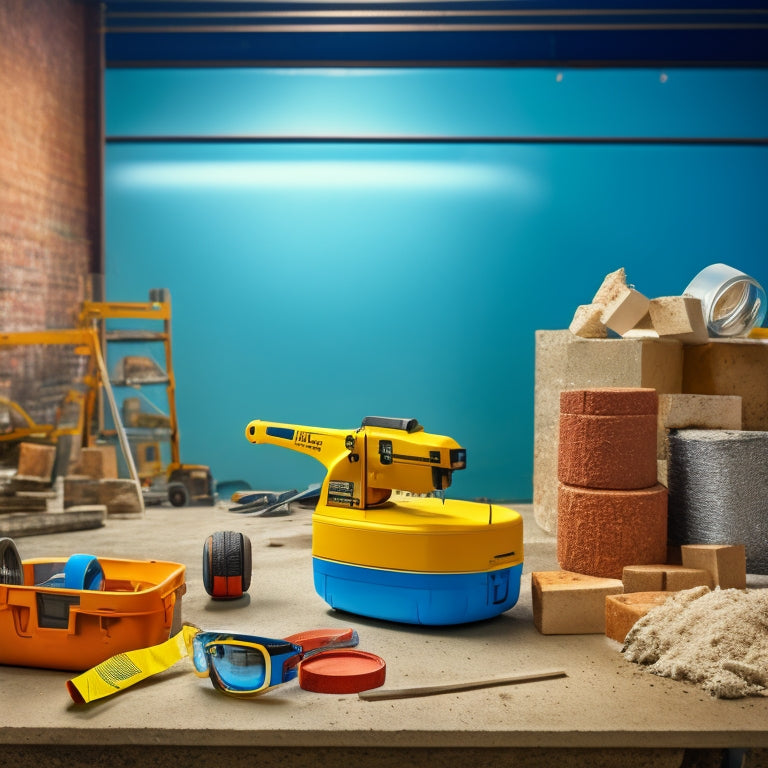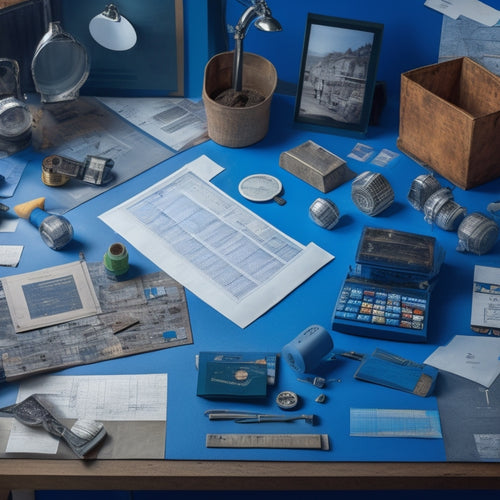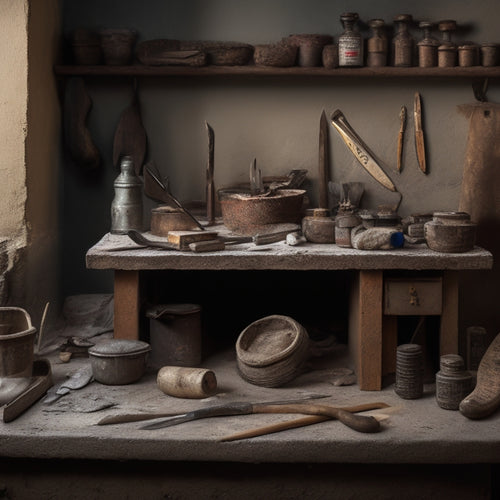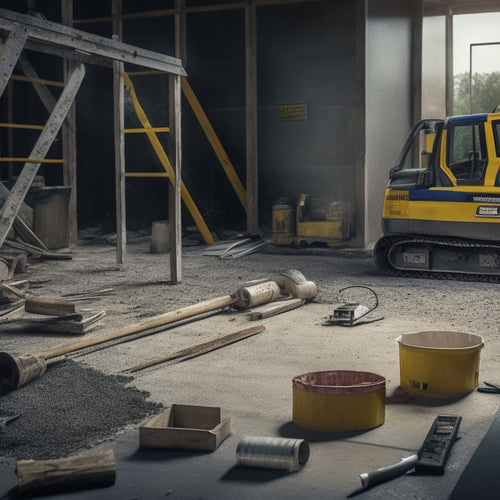
Concrete Block Saw Buying Guide for Home Renovation
Share
When buying a concrete block saw for your home renovation, you'll need to take into account the type of saw, power source, blade type, and safety features to guarantee you get the right tool for the job. With manual, electric, gas-powered, hydraulic, and walk-behind saws available, each offers unique benefits and drawbacks. Understanding the cutting techniques, maintenance requirements, and adjustments needed for different concrete types is essential. By evaluating power source options, blade type variations, and safety features, you'll be able to make an informed decision. As you explore these important factors, you'll uncover the perfect concrete block saw for your project's specific needs.
Key Takeaways
• Understand the types of concrete block saws, including manual, electric, gas-powered, hydraulic, and walk-behind saws, to choose the right one for your project.
• Consider power source options, including electric, gas-powered, and hydraulic, based on project location, scale, and performance requirements.
• Select the appropriate blade type, such as diamond, abrasive, or segmented, based on the type of concrete and desired cutting efficiency.
• Ensure safety by choosing a saw with safety certifications, emergency shut-off features, blade guards, anti-vibration handles, and safety switches.
• Establish a budget and consider warranty terms, long-term costs, and performance metrics to make an informed purchasing decision.
Understanding Concrete Block Saws
When you're tasked with cutting through concrete blocks, pavers, or walls, a concrete block saw becomes an indispensable tool in your arsenal.
To get the most out of this powerful equipment, it's vital to understand its capabilities and limitations. Familiarize yourself with cutting techniques, such as plunge cutting, rip cutting, and crosscutting, to achieve precise cuts and minimize waste. Additionally, master the art of adjusting the saw's speed and pressure to suit the type of concrete you're working with.
Regular maintenance is also important to prolong the life of your concrete block saw. Follow maintenance tips such as cleaning the blade and guard after each use, checking the saw's alignment and tension, and replacing worn-out parts promptly.
This will guarantee peak performance, reduce downtime, and prevent accidents. By mastering cutting techniques and adhering to maintenance tips, you'll be able to tackle complex projects with confidence and precision, making your concrete block saw a valuable investment for your home renovation projects.
Key Features to Consider
When selecting a concrete block saw, you'll need to take into account several key features to guarantee you're getting the right tool for the job.
You'll want to think about the power source options that best fit your needs, the type of blade that will effectively cut through various materials, and the safety features that will protect you from harm.
Power Source Options
You have three primary power source options to evaluate when selecting a concrete block saw: electric, gasoline-powered, and hydraulic.
When deciding between electric and gas-powered options, consider the trade-offs between convenience and portability. Electric saws offer a more environmentally friendly and cost-effective solution, but they're often limited by their cord length and availability of power outlets. Gas-powered saws, on the other hand, provide greater portability options, but they're noisier, heavier, and require more maintenance.
If you prioritize versatility and ease of use, electric saws might be the better choice. However, if you need to work in remote areas or on large projects, gas-powered saws are likely a better fit.
Hydraulic saws, which are often used in heavy-duty industrial applications, typically require a separate power source, such as a generator or hydraulic pump. They offer unparalleled power and precision but are generally more expensive and complex to operate.
Blade Type Variations
The type of blade you choose for your concrete block saw considerably impacts its performance, and understanding the key features of various blade types is essential for ideal results. You'll want to evaluate factors such as cutting efficiency, durability, and maintenance requirements.
Here are three key variations to evaluate:
-
Diamond Blades: These blades feature synthetic diamonds embedded in the cutting edge, providing exceptional cutting efficiency and durability. They're ideal for cutting through reinforced concrete and are relatively low-maintenance.
-
Abrasive Blades: These blades use an abrasive material, such as silicon carbide, to wear down the concrete. They're more affordable than diamond blades but may require more frequent blade maintenance tips, such as cleaning and sharpening.
-
Segmented Blades: These blades feature diamond-coated or abrasive segments separated by gaps, allowing for efficient cutting and heat dissipation. They're a good all-around option, offering a balance of cutting efficiency factors and durability.
Safety Features Incorporated
As you've carefully selected the best blade type for your concrete block saw, it's now essential to take into account the safety features that'll protect you from potential hazards and guarantee a secure cutting experience. A concrete block saw can be a hazardous tool if not used properly, and that's why it's vital to prioritize safety features when making a purchase.
Here are some important safety features to look out for:
| Safety Feature | Description | Importance |
|---|---|---|
| Safety Certifications | Meets industry standards for safety and performance | Guarantees compliance with regulations and industry norms |
| Emergency Shut Off | Allows for quick shutdown in case of an emergency | Prevents accidents and injuries |
| Blade Guard | Protects the operator from flying debris and accidental contact | Reduces risk of injury and damage |
| Anti-Vibration Handle | Reduces fatigue and improves control | Enhances operator comfort and control |
| Safety Switch | Prevents accidental start-up | Prevents unexpected start-ups and potential accidents |
When evaluating a concrete block saw, make sure to look for these safety features to guarantee a safe and secure cutting experience. Remember, safety should always be your top priority when working with power tools.
Types of Concrete Block Saws
Cutting through concrete blocks efficiently requires selecting the right type of saw, and there are several options to assess, each designed for specific applications and materials.
You'll need to take into account the trade-offs between manual and electric saws, as well as the type of blade maintenance required.
Here are three key types of concrete block saws to weigh:
-
Manual Saws: Ideal for small to medium-sized projects, manual saws are cost-effective and don't require electricity. However, they can be physically demanding and may not be suitable for large or complex projects.
-
Electric Saws: Electric saws are perfect for heavy-duty projects and can save you time and effort. They come in various power levels, from 7 to 15 amps, and are available in different blade sizes.
-
Walk-Behind Saws: Designed for large-scale projects, walk-behind saws are heavy-duty and provide maximum cutting capacity. They're ideal for professional contractors and require regular blade maintenance to guarantee peak performance.
When choosing a saw, take into account the project's scope, your budget, and your personal comfort level with maintenance and operation.
Safety Precautions and Protective Gear
Operating a concrete block saw can be hazardous, so you must wear appropriate protective gear and take necessary safety precautions to minimize risks and prevent injuries. You should always wear safety glasses, gloves, and a dust mask to protect yourself from flying debris, cuts, and respiratory issues. Additionally, wear long sleeves, pants, and closed-toe shoes to prevent skin exposure.
Follow proper handling techniques to avoid accidents. Keep your work area clean and clear of obstacles, and guarantee the saw is stable and secure before operating. Regularly inspect the saw and its components for damage or wear, and perform routine maintenance tasks as recommended by the manufacturer.
Develop emergency response procedures in case of an accident. Know what to do in case of a power outage, saw kickback, or other emergencies. Have a first aid kit nearby and know basic first aid techniques. Keep a phone nearby to call for help if needed.
Budget and Warranty Considerations
You've taken the necessary steps to guarantee a safe and successful renovation project. Now it's time to reflect on the financial implications of your concrete block saw purchase, including budget and warranty considerations.
As you evaluate your options, it's crucial to contemplate your budget constraints and how they'll impact your purchase decision.
Here are three key factors to keep in mind:
-
Set a realistic budget: Determine how much you're willing to spend on a concrete block saw, and stick to it. Be sure to factor in additional costs, such as maintenance and replacement parts.
-
Understand warranty terms: Review the warranty offered by the manufacturer, including the length of coverage, what's included, and any conditions that may void the warranty.
-
Weigh the cost-benefit ratio: Consider the cost of the saw versus its performance, durability, and features. Will a more expensive saw provide better results and last longer, or can you achieve similar results with a more affordable option?
Reading Reviews and Ratings
When researching concrete block saws, it's essential to dig deeper than manufacturer claims and sales pitches by reading reviews and ratings from real users who've put these tools to the test.
You'll get a more accurate picture of a saw's performance, reliability, and durability. User reviews provide valuable insights into the saw's strengths and weaknesses, helping you make an informed decision.
Pay attention to ratings, too; they're a quick way to gauge overall satisfaction. Look for reviews from multiple sources, including online marketplaces, forums, and specialized websites. Be cautious of fake or biased reviews, and focus on those with detailed descriptions of the saw's performance in real-world scenarios.
Rating importance varies, but generally, look for an overall rating of at least 4 out of 5 stars. Be wary of saws with low ratings or limited reviews.
Analyze the reviews to identify common praises and complaints. Are there any recurring issues with the saw's motor, blade, or ergonomic design? Do users rave about its ease of use or cutting precision?
Frequently Asked Questions
Can I Use a Concrete Block Saw to Cut Through Metal?
When you're wondering if you can use a concrete block saw to cut through metal, the answer is no.
Concrete block saws are designed for cutting through concrete, brick, and masonry, not metal. They lack the metal cutting capabilities you need for precise cuts.
Instead, consider alternative saws specifically designed for metal, such as metal-cutting circular saws or bandsaws, which are built for the task and will give you the results you need.
Are Concrete Block Saws Suitable for DIY Home Renovation Projects?
When tackling DIY home renovation projects, you're not just building a house, you're building a dream.
And, with the right tools, that dream can become a reality.
Are concrete block saws suitable for your project? Absolutely.
These saws are designed for precision and power, ensuring saw safety and project efficiency.
How Often Should I Maintain My Concrete Block Saw?
You should maintain your concrete block saw regularly to guarantee peak performance and saw safety.
Set aside time each week to inspect the saw's blade, checking for wear and damage.
Every month, clean the saw's motor and air vents to prevent dust buildup.
Additionally, follow the manufacturer's maintenance tips for lubricating moving parts and replacing worn components.
Can I Rent a Concrete Block Saw Instead of Buying One?
You're weighing your options, and rightly so.
Can you rent a concrete block saw instead of buying one? It's a cost-effective consideration.
Compare the rental fees to the purchase price, factoring in how often you'll use the saw. Rental options vary, but expect to pay around $40 to $100 per day.
If you'll only need it for a short-term project, renting might be the way to go.
Are Concrete Block Saws Compatible With Different Power Sources?
When selecting a concrete block saw, you'll want to take into account power source compatibility to guarantee peak performance.
Not all saws are created equal, and their performance can vary greatly depending on the power source.
You'll need to check if the saw is compatible with your available power sources, such as electric, gas, or hydraulic.
Factors like voltage, frequency, and power output will impact saw performance, so it's essential to match the saw with the right power source for your specific needs.
Conclusion
Cut through the confusion of choosing the perfect concrete block saw with confidence, now that you've conquered this thorough buying guide.
Craft your cut with caution, carefully considering essential factors from features to safety gear.
Crunch the numbers on budget and warranty, and critically analyze reviews.
With these clever considerations, you'll be crowned the champion of concrete cutting, effortlessly slicing through even the toughest tasks with your new trusty saw.
Related Posts
-

5 Best Home Renovation Project Timeline Checklists
You're looking for a clear understanding of the timeline for your home renovation project. A good place to start is w...
-

Stucco Tool Kit Checklist for Home Renovation
You'll need a thorough stucco tool kit to guarantee a successful home renovation, as the right tools can make all the...
-

Home Renovation Safety Checklist for Homeowners
As a homeowner initiating a renovation project, you know that safety should be your top priority. Start by establishi...


